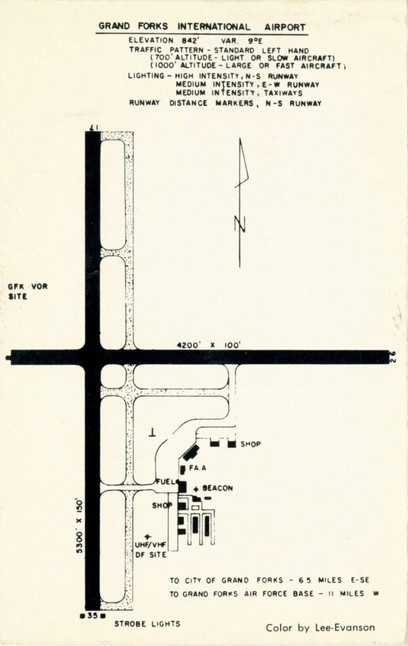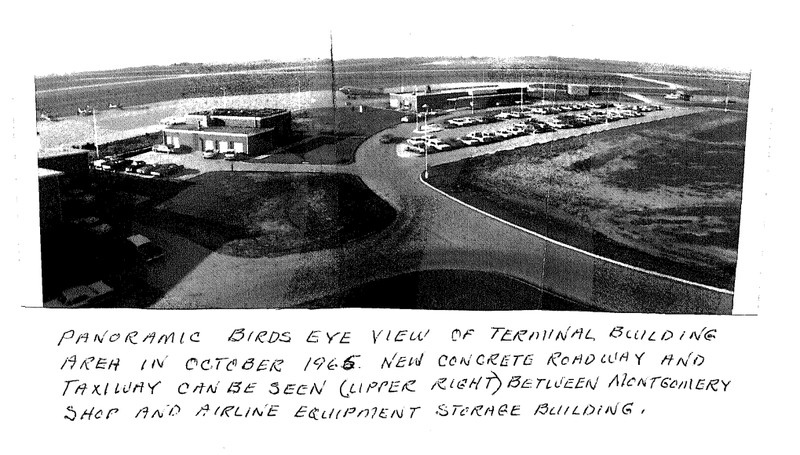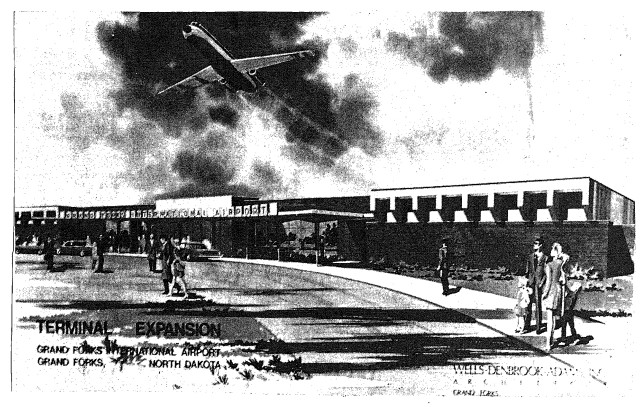Grand Forks International Airport Old Terminal (1963-2011)
Introduction
Text-to-speech Audio
During the late 1950's the city of Grand Forks was looking to upgrade their old airport in-town for something a little bigger and more modern. After much deliberation, the city finally put together funding for a $2.5 million relocation project. The new airport and terminal would be located 5 miles west of the city of Grand Forks and about 10 miles east of the Grand Forks Air force base. The new location would allow for future expansion and the new terminal would help accommodate a greater volume of passengers into the city. The terminal officially opened February 1, 1964 with two scheduled passenger flights that day. While the terminal has since be replaced with a newer one in 2011, the original terminal saw 47 years of traffic and connected the greater Grand Forks community to the skies.
Images
New Grand Forks Airport layout 1963

New Grand Forks Terminal 1964

Grand Forks Terminal Expansion Concept Art

Backstory and Context
Text-to-speech Audio
Through 1961 and 1962, the Grand Forks city council worked on a three project package to improve the city layout and support the growing population. The first of these was to add a bridge connecting Grand Forks and East Grand Forks at Skidmore Avenue (now known as Gateway Drive) and improve the existing road on Highway 2. The second project worked on Interstate 29 that runs north-south through Grand Forks. The third project was to relocate the Grand Forks municipal airport to a location 5 miles west of the city. After much work to secure funding, the first excavation work occurred April 29th, 1963.
The first passenger plane to land at the new Grand Forks International Airport was a Northwest flight that landed at 7:40am on November 15, 1963. The new terminal ran parallel with and was located just off of the main 17-35 runway. Passengers traveling through the new terminal experienced luxuries such as air conditioning as they waited for their flights. The terminal also had a restaurant where passengers would have enjoyed a meal before departing. Parking was available right outside the the terminal for passengers to leave their cars while they were gone. The Grand Forks airport terminal even welcomed President Richard Nixon in November of 1970 as he came to the state to campaign on behalf of a local candidate.
The new airport was equipped with a larger and more durable main north-south runway and a smaller east-west crosswind runway. Older airports of the day, such as the GFK municipal airport, had three runways that made a triangle shape as to attempt to accommodate for any winds. As time progressed and airport planners became more advanced, they learned to study the winds and allow for more appropriate runway directions based on that like at the new airport. Other state of the art technology was installed at the airport such as a very-high-frequency omni directional range (VOR) in 1966 and an instrument landing service (ILS) in 1968 to aid in navigation. The airport quickly received enough traffic to warrant an air traffic control tower to help with the busy congestion. Other amenities at the airport include a fixed-based operator (FBO) and a FAA office located on the field as well as many hangers to hold private aircraft. All of these facilities were overseen by the Airport Manager Norman Midboe from 1961-1984.
With the growing traffic at the airport, a terminal expansion project was put into place in 1974. This expansion made it to where passengers could board the plane directly from a sky bridge instead of walking out on the ramp and up a stair case. The expanded terminal also included a giftshop. The University of North Dakota's Aviation Program began to take off (pun intended) in the 70's under John D. Odegard as they began to acquire a fleet of planes and a few hangers in the northeast part of the airport.
After many years of use, the city of Grand Forks decided it was time to replace the now dated terminal with the new state of the art Byron L. Dorgan Terminal. The "new" terminal was not so new by the 2000s as it was cramped in the corner between the two main runways and outdated. The current terminal offers modern amenities such as an elevator and 2 skybridge gates to connect you directly with the plane. Although no longer standing, the 1963 Grand Forks International Terminal connected the United States to the North and allowed the city of Grand Forks to grow unlike ever before with the relocation of the airport.
Cite This Entry
Reese Brown and Cynthia Prescott. "Grand Forks International Airport Old Terminal (1963-2011)." Clio: Your Guide to History. May 1, 2023. Accessed April 17, 2025. https://theclio.com/entry/167071
Sources
“Finishing Touches for GFK.” Grand Forks Herald, Grand Forks Herald, 2 Oct. 2019, https://www.grandforksherald.com/business/finishing-touches-for-gfk?auth0Authentication=true.
Grand Forks International Airport, 20 Oct. 2021, https://gfkairport.com/midboe-collection/.
Norman Midboe Papers. OGLMC 1518. Elwyn B. Robinson Department of Special Collections. Chester Fritz Library. University of North Dakota, Grand Forks.
The Grand Forks Herald
Norman Midboe
The Grand Forks Herald

